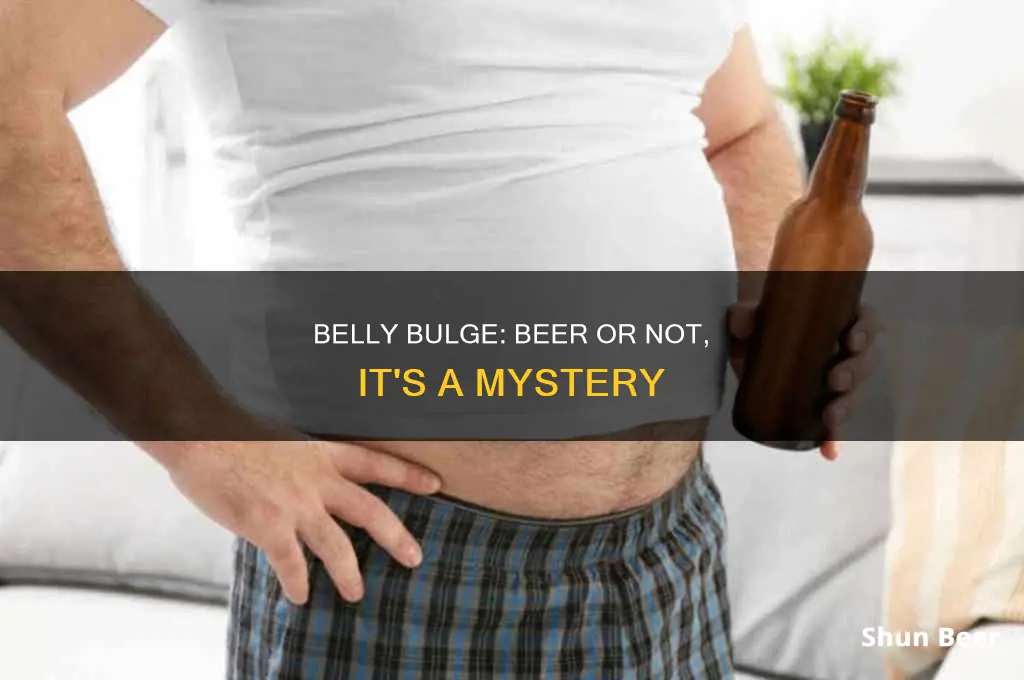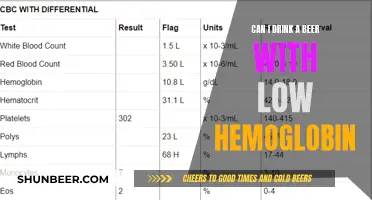
It's a common misconception that beer is the sole cause of a beer belly. While alcohol does seem to have a particular association with fat in the midsection, it's actually any excess calories that can turn a trim waistline into a protruding belly. These excess calories can come from alcohol, sugary drinks, fried foods, desserts, or oversized portions. The good news is that when you start losing weight, you tend to lose it in the midsection first.
| Characteristics | Values |
|---|---|
| Calories | Consuming too many calories can lead to a beer gut, regardless of the source. Alcohol calories are easily overdone, and drinking leads to eating high-calorie foods. |
| Alcohol | Alcohol is associated with bigger waists as the liver burns alcohol instead of fat. |
| Age | Older people tend to have more prominent beer bellies due to reduced activity levels and lower calorie requirements. |
| Sex | Men are more likely to store fat in their abdomen due to lower levels of subcutaneous fat. |
| Hormones | Hormone changes, such as menopause, can lead to increased fat storage around the middle. |
| Smoking | Smokers may deposit more fat in their bellies, according to studies. |
| Stress | High levels of the stress hormone cortisol are linked to increased fat storage around the belly. |
| Sleep | Lack of sleep can lead to unhealthy eating patterns and increased calorie consumption. |
What You'll Learn

Calories from other foods and drinks can cause a beer gut
In general, any excess calories, whether from alcohol, sugary drinks, or oversized portions of food, can increase belly fat. When you consume more calories than you burn, the excess calories are stored as fat. The location of fat storage in the body is influenced by age, sex, and hormones. As people age, their calorie needs decrease, and they tend to become less active, making it easier to gain weight.
Hormone levels also play a role in fat distribution. Men tend to store more fat in their abdomen due to having less subcutaneous fat, while women have more subcutaneous fat in their thighs, buttocks, arms, and belly. As hormone levels decline with age, both men and women become more likely to store fat around the midsection.
Additionally, alcohol consumption can interfere with the body's ability to burn fat efficiently. When you drink alcohol, your liver prioritizes burning alcohol for energy instead of breaking down stored fat. This can lead to an accumulation of fat in the abdominal area.
To prevent or reduce a beer gut, it's important to focus on managing your overall calorie intake and engaging in physical activity. Making healthier food choices, such as opting for lean proteins, vegetables, and healthy fats, can help reduce calorie intake and promote weight loss. Increasing physical activity, especially aerobic exercises like running, swimming, and cycling, can also help burn visceral fat and reduce belly fat.
Christians and Beer: Is Drinking Sinful?
You may want to see also

Alcohol causes the liver to burn alcohol instead of fat
Alcohol is often referred to as "empty" calories, providing the body with calories but very few nutrients. When alcohol is consumed, the body uses it as a primary source of fuel before burning glucose from carbohydrates or lipids from fats. This means that excess glucose and lipids are stored as fat.
The liver plays a crucial role in metabolising fats, carbohydrates, and proteins. However, when alcohol is present in the body, the liver focuses on metabolising it instead. This process can take 12 to 36 hours, depending on the individual and the amount consumed. During this time, the liver's ability to metabolise fat is significantly reduced.
Alcohol consumption can lead to alcoholic fatty liver, a condition that damages the liver and affects its ability to metabolise and store carbohydrates and fats. This change in the way the body stores energy from food can make it challenging to lose weight.
In addition to its direct impact on the liver, alcohol can also contribute to excess belly fat. This is partly due to the high-calorie foods often consumed alongside alcoholic drinks, such as pizza, wings, and other fried foods. Alcohol can also increase appetite and trigger hunger signals in the brain, leading to increased food intake.
To summarise, alcohol causes the liver to prioritise burning alcohol instead of fat. This disruption in the body's metabolic processes can lead to weight gain and increase the risk of health problems associated with excess belly fat.
Beer and Piles: A Safe Mix?
You may want to see also

Visceral fat is found in the abdominal cavity and surrounds organs
It is a common misconception that only beer drinkers can have a "beer belly". While alcohol consumption is associated with bigger waists, it is not the only cause of a beer belly. Any excess calories, whether from alcohol, sugary drinks, or large portions of food, can increase belly fat.
Visceral fat is found deep within the abdominal cavity and surrounds vital organs such as the stomach, liver, intestines, and pancreas. It is different from subcutaneous fat, which is found just below the skin. While some levels of visceral fat are healthy and protective of our organs, too much can be dangerous. It is sometimes called "active fat" because it plays an active role in how our bodies function. Excess visceral fat has been linked to serious health issues such as diabetes, heart disease, stroke, and even certain types of cancer.
The only definitive way to diagnose visceral fat is with a CT or MRI scan. However, due to the time and expense involved, healthcare providers typically use general guidelines to evaluate a person's visceral fat and the associated health risks. It is estimated that visceral fat makes up about 10% of a person's total body fat. If a person's body fat percentage is higher than recommended, their visceral fat range will also be higher.
There are several methods to measure visceral fat levels at home, including waist circumference, waist-to-hip ratio, body mass index (BMI), and waist-height ratio. For women, a waist circumference of 35 inches or more indicates a risk of health problems stemming from visceral fat, while for men, the number is 40 inches or more. Similarly, a waist-to-hip ratio above 0.85 for women and 0.90 for men indicates abdominal obesity. A BMI of 30 or more indicates potential overweight and visceral fat concerns. Finally, a waist-height ratio of no greater than 0.5 is considered healthy for both men and women.
To reduce visceral fat, it is essential to maintain a healthy lifestyle. This includes regular exercise, a healthy diet, adequate sleep, stress reduction, and limiting alcohol intake. Exercise should be performed for at least 30 minutes a day and can include cardio, strength training, or high-intensity interval training (HIIT). A healthy diet should include lean proteins, whole grains, low-fat dairy, fruits, and vegetables, while limiting trans fats, refined sugars, sodium, and processed foods. Getting a good night's sleep of at least seven hours is also important, as lack of sleep may increase visceral fat. Reducing stress through practices like yoga or meditation can also help, as stress activates the hormone cortisol, which triggers the storage of more visceral fat. Finally, limiting alcohol intake is crucial, as alcohol provides empty calories and interferes with the body's ability to burn fat efficiently.
Old Beer: Is It Safe to Drink After Years?
You may want to see also

Men are more prone to storing fat in the abdomen
Additionally, men and women have varying amounts of essential and stored fat. Women naturally carry more body fat than men, with active women typically having 21% to 24% body fat, compared to 14% to 17% in men. This difference is attributed to the role of women's bodies in caring for and nurturing a growing baby. The fat reserves in women are essential for pregnancy and nursing. During puberty, estrogen production enables women to develop these necessary fat reserves.
The type of fat stored also differs between men and women. Women tend to have more subcutaneous fat, which is located under the skin and gives them their soft curves. In contrast, men are more prone to storing visceral fat, which coats the internal organs. Visceral fat is of greater concern when it comes to health risks. It is closely associated with fat-related illnesses such as heart disease and type 2 diabetes.
The distribution of body fat can be influenced by factors like bone structure, body type, age, hormones, and sex. While men are more prone to storing fat in the abdomen, it's important to note that both men and women need to maintain a certain percentage of essential fat for normal bodily functions.
Beer and GERD: What You Need to Know
You may want to see also

A combination of diet and exercise is needed to lose a beer gut
Even if you don't drink beer, you can still develop a "beer gut" or "beer belly". This is because any excess calories, whether from alcohol, sugary drinks, or large portions of food, can increase belly fat. However, alcohol consumption, particularly among men, is associated with "abdominal obesity" or a "beer belly".
To lose a beer gut, a combination of diet and exercise is needed. Here are some tips to help you lose a beer gut:
Diet
- Reduce your calorie intake: This can be done by cutting your portion sizes in half. For example, instead of having two slices of pizza, have one. Over time, you'll get used to consuming smaller portions.
- Eat more nutritious foods: Include more fruits, vegetables, whole grains, and lean proteins in your diet. At the same time, reduce your intake of processed foods, added sugars, enriched flour, and saturated fats.
- Make healthy food swaps: Instead of ice cream, try strawberries for dessert. Drink water flavoured with lemon or lime instead of soda. Use healthier fats like olive oil instead of butter when cooking.
- Increase your protein intake and reduce carbohydrates: Beer contains sugar and carbohydrates, which can hinder fat loss. By increasing your protein intake and reducing carbs, you can accelerate fat loss, reduce hunger, and improve your ability to build muscle.
- Try intermittent fasting: Various methods of intermittent fasting can help control your hunger, improve insulin sensitivity, and reduce overall calories. Popular methods include the Warrior Diet (20-hour fast/4-hour feed), Leangains Method (16-hour fast/8-hour feed), and the 5/2 method (eat regularly for five days and then reduce your calorie intake to 400-800 calories for two days).
Exercise
- High-intensity interval training (HIIT): This involves short bursts of intense exercise followed by brief rest periods. It is effective for burning fat and accelerating weight loss. A good starting point is the 7-Minute Workout or exercises like burpees.
- Aerobic exercise: Aim for at least 30 minutes of moderate-intensity aerobic exercise, such as running, swimming, cycling, or tennis, most days of the week.
- Strength training and stretching: Incorporate strength training and stretching into your routine at least two days a week, preferably in the morning and evening.
- Weight lifting: Building muscle increases your metabolism, as your body needs to burn more calories to fuel your muscles. Studies show that weight training can increase your metabolism for up to 48 hours after a workout.
- Mini-workouts: Sneak in some extra movement with mini-workouts throughout your day. For example, try a 10-minute kettlebell swing and burpee combo, resting as needed.
Drinking Beer on Spanish Streets: What's Allowed?
You may want to see also
Frequently asked questions
A beer gut is caused by consuming too many calories, which can come from alcohol, sugary drinks, fried foods, desserts, or oversized portions. As you get older, your body tends to store more fat in your abdomen due to decreased physical activity, lower calorie requirements, and changing hormones.
A beer gut, or abdominal obesity, is linked to various health issues, including type 2 diabetes, high blood pressure, and cardiovascular disease. It can also increase your risk of heart disease and is associated with overall mortality.
To get rid of a beer gut, you need to reduce your overall body weight by creating a calorie deficit. This can be achieved through a combination of dietary changes, such as controlling portion sizes, limiting carb and sugar intake, and increasing your physical activity with aerobic exercises and strength training.







